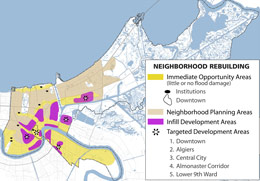 |
|
This map of New Orleans shows part of the federally designated disaster area (DDA) that followed hurricanes Katrina and Rita in 2005. Such maps help banks target their financial recovery efforts for community redevelopment, assuring consistency with the disaster recovery plans and geographic compliance with CRA requirements. See “Rebuilding Communities After a Disaster” for more details about addressing DDAs. |
Source:
Bring New Orleans Back Commission
|
|
|
The four federal banking regulatory agencies completed their congressionally mandated review of the Community Reinvestment Act (CRA) nearly a year ago. That review produced some of the most significant changes in the law’s 29-year history. The definition of “community development” was broadened in an effort to provide more flexibility for institutions serving rural locales as well as federally designated disaster areas. The review also sought to reduce the regulatory burden on small banks with assets between $250 million and $1 billion and to provide them with more flexibility in complying with CRA while still encouraging them to lend and invest in their communities.
Also over the past year, the regulators have identified new geographic areas that are now eligible under the broadened community development definition and have provided clarification on the revised regulation by issuing new “Questions and Answers.” In addition, corresponding clarifications issued under the OCC’s Part 24 public welfare investment authority (12 CFR 24) explain what new types of Part 24 investments are eligible under the expanded CRA definition of “qualified investments.”
In this edition of Community Development Investments, we discuss the factors that a bank in the $250 million to $1 billion asset range should keep in mind when deciding whether to be treated as an “Intermediate Small Bank” or “Large Bank” in its next CRA examination, and we look at how banks and examiners alike are approaching the new CRA rules. This issue answers some of the questions most frequently put to OCC’s District Community Affairs Officers when they meet with banks about their options under the new CRA regulations. Finally, we review the types of investments now eligible under the Part 24 public welfare investment authority that were not permitted in the past.
As customary in Community Development Investments, our District Community Affairs Officers report on new investment opportunities from around the country. They are available to answer questions about these investments, as well as questions about the new CRA rules or Part 24 interpretations.
We hope that you find this E-zine helpful as your bank implements its CRA program. If you would like to share your thoughts about this edition, or suggest topics for future editions, please contact me at the e-mail address below.
Barry Wides
Deputy Comptroller
Community Affairs
Community.Affairs@occ.treas.gov
|